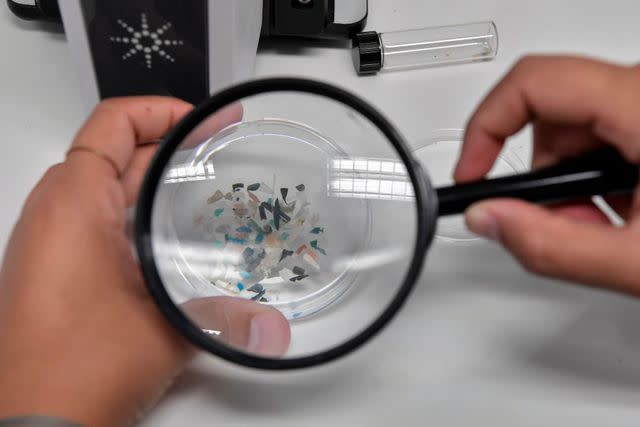Study: Microplastics Found in Clogged Arteries Linked to Greater Risk of Heart Attack, Stroke
Fact checked by Nick Blackmer
In a three-year study, having microplastics and nanoplastics in artery-clogging plaque put a person at nearly five times higher risk for having a stroke or heart attack.
Experts say the mounting evidence showing an association between microplastics and poor health outcomes does not show causation, but the findings are alarming enough to warrant much more research.
Virtually every person on Earth has been exposed to plastic. It’s becoming clear that tiny fragments of this plastic are becoming part of the human body.
Having microplastics and nanoplastics lodged into the fatty plaque lining arteries may raise a person’s risk of stroke, heart attack, or death by nearly five-fold, a new study suggests.
The study, published in the New England Journal of Medicine, compared health outcomes between people with arterial plaque containing these tiny plastic particles and people whose plaque did not.
“Nobody was expecting to see such a huge difference between having or not having nanoplastics in the plaques,” study author Antonio Ceriello, MD, head of the diabetes department at IRCCS MultiMedica in Milan, Italy, told Health. “A five times higher risk for heart attack is an enormous difference."
Nanoplastics are less than 1 nanometer long. Microplastics are a bit bigger, ranging from 1 nanometer to 5 millimeters, or about the size of a pencil eraser.
These degraded plastic particles are everywhere, from Arctic snow to lakes and rivers. Scientists have also discovered them in human lungs, placenta, breast milk, and, most recently, arteries.
Made up mostly of cholesterol and fatty substances, plaque buildup in and of itself raises the chances of cardiovascular problems. Still, the new research shows that the addition of plastic particles may further heighten that risk.
“That’s pretty concerning,” said Mary Johnson, MD, PhD, a research scientist at Harvard T.H. Chan School of Public Health specializing in environmental health.

LOUISA GOULIAMAKI / Contributor / Getty Images
Finding a Connection Between Microplastics and Heart Health
Ceriello and his team examined plaque samples taken from 257 adults.
The participants were considered at high risk for heart disease and required the removal of plaque buildup in their carotid arteries, the blood vessels on the sides of the neck that carry blood and oxygen between the heart and brain.
Since the participants had to get the plaque removed anyway, it created an easy opportunity for researchers to analyze samples from living people. Most of the research finding microplastics in human tissues has examined samples from people who have died.
The team detected polyethylene, the most common type of plastic, in 150 people, or about 60% of participants. About 12% also had measurable amounts of polyvinyl chloride or PVC. Researchers found more nanoplastics than microplastics lodged in plaque.
The researchers followed up with participants for about three years to monitor their health status. After adjusting for factors that put a person at high risk for heart disease, such as older age and having type 2 diabetes, the team found that those with microplastics or nanoplastics in their plaque were 4.5 times more likely to have had a stroke or heart attack, or to have died within the three-year timeframe.
As an observational study, the research showed only an association between plastic and a higher risk of a cardiovascular event or death; it doesn’t prove that the presence of plastic caused this increased risk.
“Associations don’t necessarily mean causality,” Pankaj Pasricha, MD, chair of the department of internal medicine at the Mayo Clinic in Arizona, told Health. However, he added that the association between the two was “robust.”
“These people were high risk for cardiovascular disease, so they were well treated for blood pressure and thrombosis,” Ceriello said. “The only difference was the plastic, and we found this huge difference.”
How Do Microplastics Cause Disease?
According to Johnson, researchers have some idea as to how microplastics and nanoplastics may set off a chain of events that could lead to disease.
One theory is that the material itself is the trigger, Johnson said. A recent report found that at least 4,200 of the 16,000 unique chemicals identified to make plastic are considered “highly hazardous” to human health and the environment.
“It’s not just the particle itself; it’s the additives used in the making of the plastic that can also cause harm,” she explained.
Furthermore, studies examining the effects of adding microplastics to cells or animals suggest inflammation may play a role.
“It’s a foreign substance, and there is some kind of inflammatory mechanism that gets engaged whenever you have a foreign substance in your body,” Pasricha said. “Sometimes that’s subtle, sometimes that’s covert. Sometimes, it activates the immune system in a way we don’t fully know.”
Research on humans is necessary to understand the underlying mechanism, Pasricha added, as well as other ways that plastic particles might affect human health.
This is especially true given its ubiquity, experts say. “Plastic is pretty much everywhere,” Johnson said. “We’ve all been exposed to it.”
For more Health.com news, make sure to sign up for our newsletter!
Read the original article on Health.com.

